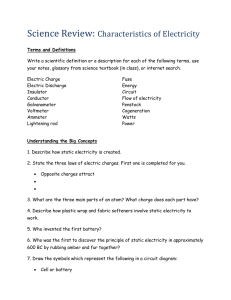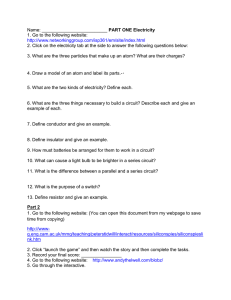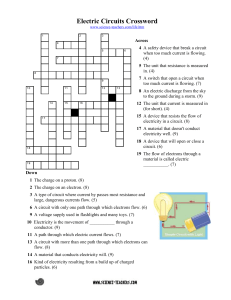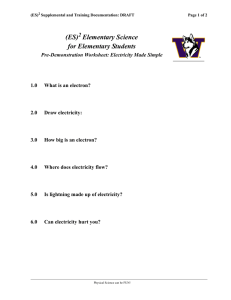E UNIT Review
advertisement
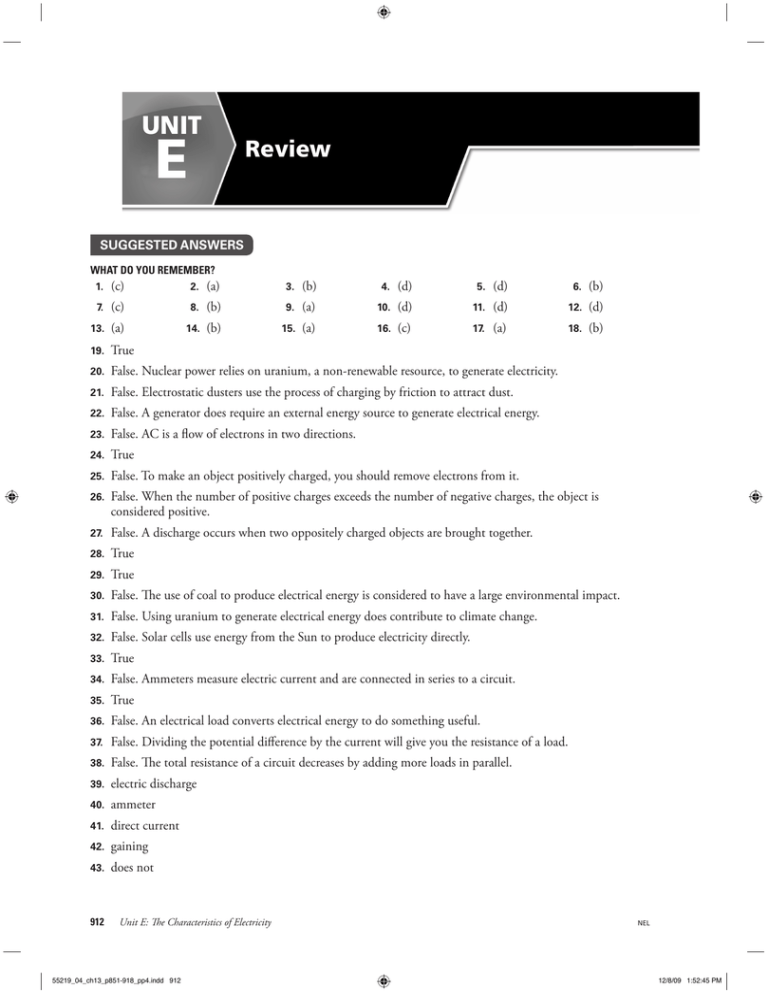
UNIT E Review SUGGESTED ANSWERS WHAT DO YOU REMEMBER? 1. (c) 2. (a) 3. (b) 4. (d) 5. (d) 6. (b) 7. (c) 8. (b) 9. (a) 10. (d) 11. (d) 12. (d) 13. (a) 14. (b) 15. (a) 16. (c) 17. (a) 18. (b) 19. True 20. False. Nuclear power relies on uranium, a non-renewable resource, to generate electricity. 21. False. Electrostatic dusters use the process of charging by friction to attract dust. 22. False. A generator does require an external energy source to generate electrical energy. 23. False. AC is a flow of electrons in two directions. 24. True 25. False. To make an object positively charged, you should remove electrons from it. 26. False. When the number of positive charges exceeds the number of negative charges, the object is considered positive. 27. False. A discharge occurs when two oppositely charged objects are brought together. 28. True 29. True 30. False. The use of coal to produce electrical energy is considered to have a large environmental impact. 31. False. Using uranium to generate electrical energy does contribute to climate change. 32. False. Solar cells use energy from the Sun to produce electricity directly. 33. True 34. False. Ammeters measure electric current and are connected in series to a circuit. 35. True 36. False. An electrical load converts electrical energy to do something useful. 37. False. Dividing the potential difference by the current will give you the resistance of a load. 38. False. The total resistance of a circuit decreases by adding more loads in parallel. 39. electric discharge 40. ammeter 41. direct current 42. gaining 43. does not 912 Unit E: The Characteristics of Electricity 55219_04_ch13_p851-918_pp4.indd 912 NEL 12/8/09 1:52:45 PM 44. ground; grounding 45. contact 46. atomic nuclei 47. Sun 48. parallel; series 49. potential difference; parallel 50. slope 51. the same 52. the same 53. release 54. (a)(i); (b)(iii); (c)(v); (d)(ii); (e)(iv) WHAT DO YOU UNDERSTAND? 55. Charge Location in Atom Ability to Move (a) neutrons no charge in the nucleus do not move (b) protons charge of 11 in the nucleus do not move (c) electrons charge of 21 found in energy levels around the nucleus easy to move in some materials 56. (a) 57. To make an object neutral, connect the object to the ground with a conducting wire. (b) To make an object positively charged, attach a grounding wire to the neutral object. Then bring a negatively charged object close so that both objects are very close or touching. Remove the grounding wire while the two objects are close or touching. (c) To make an object negatively charged, bring a negatively charged object close so that both objects are touching. Objects with like charges repel; objects with unlike charges attract. 58. ⴙⴚ ⴚⴙⴙ ⴙⴚ ⴚ ⴚⴙ ⴙ ⴚ Rodⴙⴚ iveⴚⴚⴚ ⴚ t a ⴙ ⴚⴚ Neg ⴙ ⴚⴚ ⴚⴚ neutral ball ground negative rod drives electrons to ground by induction ⴙⴚ ⴚⴙⴙ ⴙⴚ ⴚ ⴚⴙ ⴙ ⴚ ⴙⴙ ⴙ ⴙ ⴙ ⴙ remove rod positive charge left on ball remove ground ground ground 59. Metals are good conductors of electricity. As a result, lightning can travel easily and safely through the metallic rod to the ground. 60. The rest of the energy is converted into thermal energy, or heat. 61. The voltage drop across each load decreases as the number of loads in the series circuit increases. NEL 55219_04_ch13_p851-918_pp4.indd 913 Unit E Review 913 12/8/09 1:52:55 PM 62. After Before ⴚ ⴙ ⴚ ⴙ ⴚ ⴚ ⴙ ⴚ 63. 64. ⴚ ⴙ ⴚ ⴚ ⴙ ⴙ ⴚ ⴙ ⴚ ⴙ ⴚ ⴙ ⴚ ⴚ ⴙ ⴚ ⴙ ⴙ ⴚ ⴙⴚ ⴙⴚ ⴚ Resistance (Ω) Voltage (V) Current (A) Circuit A 36 90 2.5 Circuit B 350 175 0.5 Circuit C 150 120 0.8 A toaster oven is much smaller than a regular oven, so it requires less energy to attain a temperature high enough to heat a pizza slice. Because a slice of pizza could probably fit in a toaster oven, it would be more efficient to use the toaster oven for this task. SOLVE A PROBLEM 65. Touch the electroscope with a negatively charged conductor. 66. You have been given some fur, an ebonite rod, a glass rod, and a piece of polyester. Your teacher asks you to charge the objects by friction. What combinations will you use? Explain why this will work. Fur is above glass and polyester is above ebonite in the electrostatic series. So to make the glass rod negatively charged, rub it with fur. To make the ebonite rod negatively charged, use either fur or polyester. 67. (a) (b) 68. (a) (b) 69. (a) The electroscope leaves are apart and have a negative charge. The electroscope overall is still neutral; this means the charging is by induction. So a negatively charged object must be inducing the negative charge on the electroscope. The pith ball overall is neutral and the charges are randomly distributed. So a neutral object must have been brought near an already neutral pith ball. Series circuit: V1 5 V2 5 V3 5 6.0/3 5 2.0 V. I1 5 I2 5 I3 5 1.0 A. Parallel circuit: V1 5 V2 5 V3 5 6.0 V. I1 5 I2 5 I3 5 1/3 5 0.33 A. Series circuit: total resistance: RT 5 Vsource/Isource 5 6.0/1.0 5 6.0 Ω resistance of each lamp: R1 5 V1/I1 5 2.0/1.0 5 2.0 Ω (b) Parallel circuit: total resistance: RT 5 Vsource/Isource 5 6.0/1.0 5 6.0 Ω resistance of each lamp: R1 5 V1/I1 5 6.0/0.33 5 18 Ω 70. (75–0)/(1.2–0) 5 62.5 Ω The resistance is 62.5 Ω. 71. V/I 5 115/12.0 5 9.58 Ω The resistance of the toaster is about 9.6 Ω. 72. I 5 V/R 5 3.6/50.0 5 0.072 A or The current going through this circuit is 72 mA. 73. V 5 IR 5 (0.020)(75) 5 1.5 V The voltage drop across the watch’s battery is 1.5V 914 Unit E: The Characteristics of Electricity 55219_04_ch13_p851-918_pp4.indd 914 NEL 12/8/09 1:52:56 PM 74. Electronic items may come in contact with charged objects during shipping, which could damage the items. Anti-static bags enclose electronic items and prevent them from being damaged by electric discharges. 75. (a) (b) 76. Power (W) Time per Month (h) kW·h per month Cost Television 210 20 4.20 $0.50 Computer 150 32 4.8 $0.58 Video Game System 180 8 1.44 $0.17 24 h/day 3 30 days/month 5 720 h/month; 720 h/month 3 0.15 kW 5 108 kW . h/month. The dam will change the way the river flows in the area. Some aquatic animals may not be able to migrate properly. The dam could also cause major flooding, which would force communities to relocate. The dam would very likely cause a water shortage in areas that previously had access to water from the river. Create and Evaluate 77. The manufacturer could start by increasing the efficiency of their products, so the useful energy out is as close as possible to the energy in. One way this might be done would be to use copper wiring instead of aluminum in the device, because copper is a better conductor than aluminum. Making devices as light and small as possible also usually saves electricity. Also, a switch on the device that truly turns off the power instead of keeping the device on standby could save a lot of electricity. On the manufacturing side, savings inside the factory could be made in similar ways—using electrically efficient equipment, developing a better manufacturing process that uses less resources and recycles waste products, and shutting off power when not needed. The company could also produce some or most of its electricity using renewable resources such as solar or wind. If the company doesn’t have enough money to buy solar panels or a wind turbine, they could buy electricity from a supplier that produces “green” electricity. 78. The use of sensors that shut off lights and other electrical devices when they detect no one is in a room could save electricity. Other ways to reduce electrical energy consumption are to buy energy-efficient appliances, operate washing machines only if you have full loads, dry clothes on a clothes line, do more activities during the daytime or in rooms with more natural light to reduce the need for artificial lights, and avoiding the use of devices that are not necessary. 79. Non-renewable resources are the traditional types of resources used to generate electrical energy. The technology has been used for a long time and represents a huge existing investment. It will take time before alternative renewable sources can replace them. Government policies have a lot to do with why we continue to use non-renewable resources. 80. Like any technology, there are difficulties with renewable energy sources. Solar panels are very expensive and require appropriate government policies to make their widespread use successful. They also produce electricity slowly, over the course of a day. Wind turbines and towers are expensive. Geothermal and tidal sites are few in number and require appropriate sites. Biomass generation could require the turning over of land for food production to energy production. 81. Check to see that students’ designs incorporate information about static electricity. For example, students could create a design that includes materials, such as polyester, that would attract hair. Students should justify their choice of materials by explaining how charge accumulates on the material, and how that charge could be used to attract dust. Students’ diagrams should show a charged object attracting dust particles. 82. The design will probably rely on current electricity, because this type of electricity can be readily controlled through an electrical circuit. The circuit will include a load that converts electrical energy into thermal energy. Static electricity, on the other hand, is not as easily controlled, so it would not be appropriate for this design. NEL 55219_04_ch13_p851-918_pp4.indd 915 Unit E Review 915 12/8/09 1:52:57 PM 83. ⴙ ⴚ 84. Sample answer: I would construct a simple circuit using the battery, the light bulb, and the cooper wire. I would then splice the wire to make a place where the material being tested could be inserted (with copper wire attached to each end). After the insertion of each material being tested, I would check to see if a current could travel through the circuit by seeing if the light bulb lights up. If the light bulb lights, the material is a conductor; if the light bulb fails to light, the material is an insulator. REFLECT ON YOUR LEARNING 85. Sample answer: I support the use of renewable energy sources to produce electricity, as well as energy conservation. My classmates tend to agree that conservation is easier to accomplish than substituting renewable energy sources for non-renewable ones. To conserve, we can cut down on electricity use and be smart about using it. To get renewable energy for our community, we will need to push governments to change energy policies. To do this, we 86. (a) (b) Sample answer: Electricians and computer technicians are two occupations that directly apply an understanding of electricity. Sample answer: Yes, I plan to be a forensics investigator. Forensics investigators apply knowledge of electricity when they use electrostatic lifting to make copies of footprints. WEB CONNECTIONS 87. Sample answer: I would require each minister to be extremely creative and “think outside the box.” I would want that each minister is honest and strong-willed to do what is “right,” rather than do what is easy. I would also want each minister to think long-term and have a clear vision of the “big picture,” rather than focus on ineffective band-aid solutions. Each minister should be well-educated in the science and the business side of each ministry. The Minister of Energy would need to know the costs and benefits of all energy options in economic, environmental, and social terms. He or she would need to appreciate the urgency of issues like climate change and oil depletion. That said, the minister would also need to be smart and creative to figure out ways to actively engage citizens to make them part of the solution. The Minister of Transportation would have to know how to be smart about making better use of our transportation infrastructure. The minister would have to figure out the best ways to move the most people with the least resources and the least on-going infrastructure cost. This would mean trains would have to become the main form of transportation, not cars. The minister would encourage people to live where they work to reduce long distance travel. This would result in less traffic and smaller communities having improved economies. The Minister of Natural Resources would have to be creative to find ways to make the most of limited resources. Thinking long-term would be critical because environmental costs are very significant. If the minister creates the appropriate government policies, renewables can have a fair footing in the marketplace. The minister must know how to get as many citizens personally involved in reducing their energy use and their use of other resources. Financial barriers need to be dealt with; otherwise, nothing will change. Technical expertise would need to be combined with common sense and compassion. 916 Unit E: The Characteristics of Electricity 55219_04_ch13_p851-918_pp4.indd 916 NEL 12/8/09 1:52:57 PM

